The Forks – Winnipeg’s Kick Ass Destination
I used to live in Winnipeg – the key words being ‘used to’. Frankly, I couldn’t wait to get out of the place when I moved to Nova Scotia to attend law school and that’s where I’ve remained ever since. However, I still have family and friends in Winnipeg and have returned many times over the years. During the course of those visits I have witnessed Winnipeg, which once was an ugly duckling, gradually transform itself into a swan. After my most recent visit I would say the transition is complete and Winnipeg is now one of the most vibrant cities in the country and The Forks may well be the absolute best urban space in Canada. Here’s why.

Map of The Forks National Historic Site (Courtesy of TripAdvisor)
So what makes for a great urban space – a lot of factors and The Forks has them all. Firstly, by definition, it needs to be a space inside an urban area. Check. Secondly it needs to have a great natural location. The confluence of the Red and Assiniboine Rivers (aka The Forks) fits the bill perfectly. While it’s not overly dramatic, it is a natural combination of land and water that can be enjoyed both ways. So for #2 – check. Thirdly, it should have an historical component that compliments the natural beauty of the area. The Forks has been an important meeting place for thousands of years, in fact, it’s one of the most important and oldest National Historic Sites in Canada. Check on #3. Fourthly, it should be accessible and of interest to people of all ages, ethnicities and abilities. With everything from a children’s museum to boat rides to shopping to star gazing, there’s something for everyone at The Forks. Again, check on #4. With all these things to draw people to The Forks, it should have great food and accommodation. Check on this with The Forks Market and the Inn at the Forks, my favourite place to stay in Winnipeg by a country mile. #6 on the check list is a chance to browse and buy at stores that are unique to the urban space and reflect the culture and handicrafts of the area i.e. no national chain stores and predominantly locally made products for sale. Yes, The Forks has that as well. Next it should be a great place to just chill out and enjoy a beer or glass of wine and take in the rays that favour Winnipeg most days of the summer. With the recent opening of The Common at The Forks you have a choice of 20 beers on tap or 20 wines to select from. Take your beverage of choice, find one of the many types of seating available and be entertained by the buskers, watch the boats go by on the river or just enjoy being in the company of friends or strangers who are all loving this place called The Forks. Lastly, and I think this is the most important from a tourist’s perspective, the urban space must be a genuine local attraction and not something built just to lure in tourists. The Forks really nails this as, while there are lots of tourists, Winnipeggers outnumber them by far. This is their urban space and they love it and I do too.
Let’s take a deeper dive into why The Forks is so appealing.
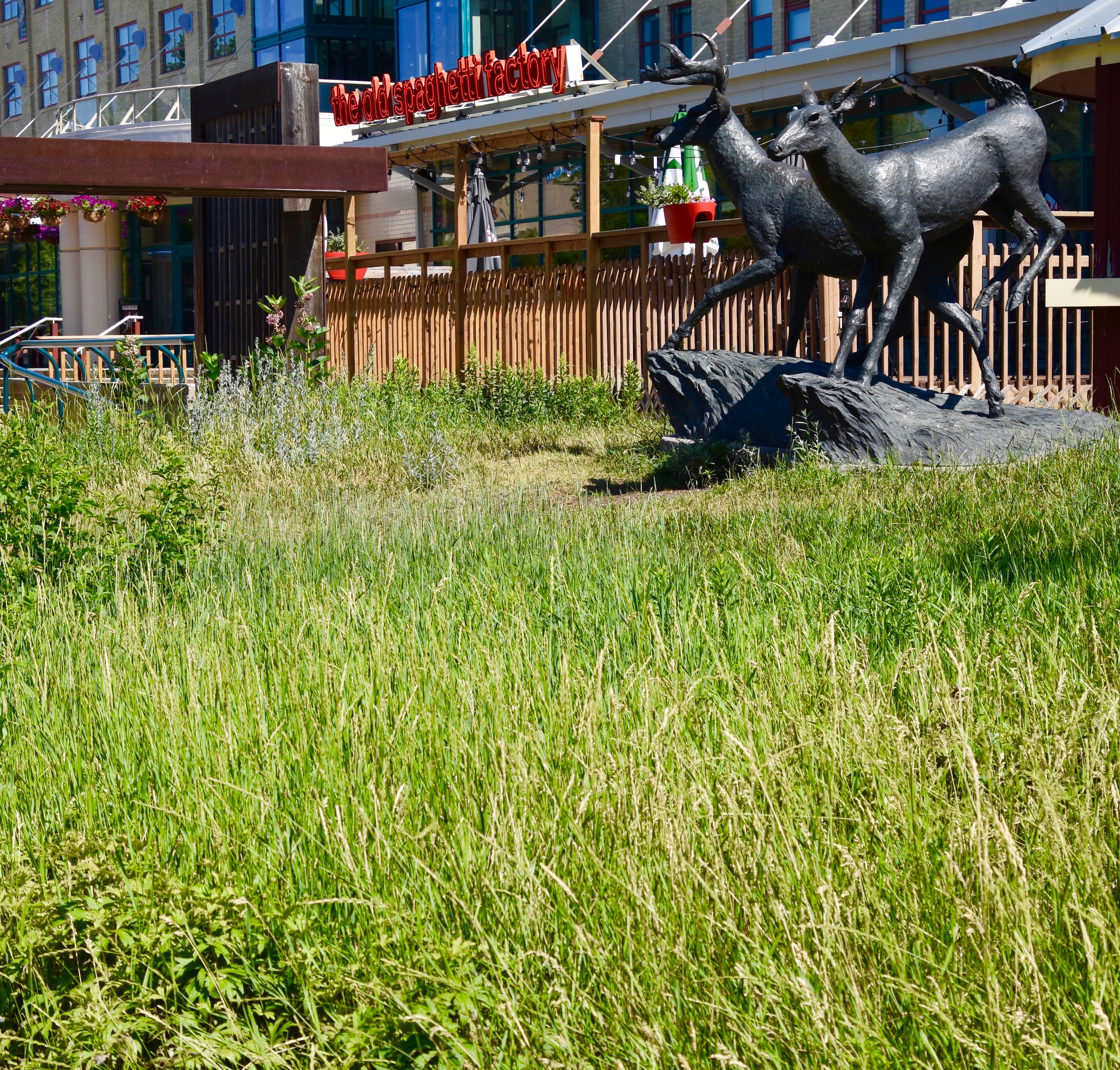
The Forks National Historic Site
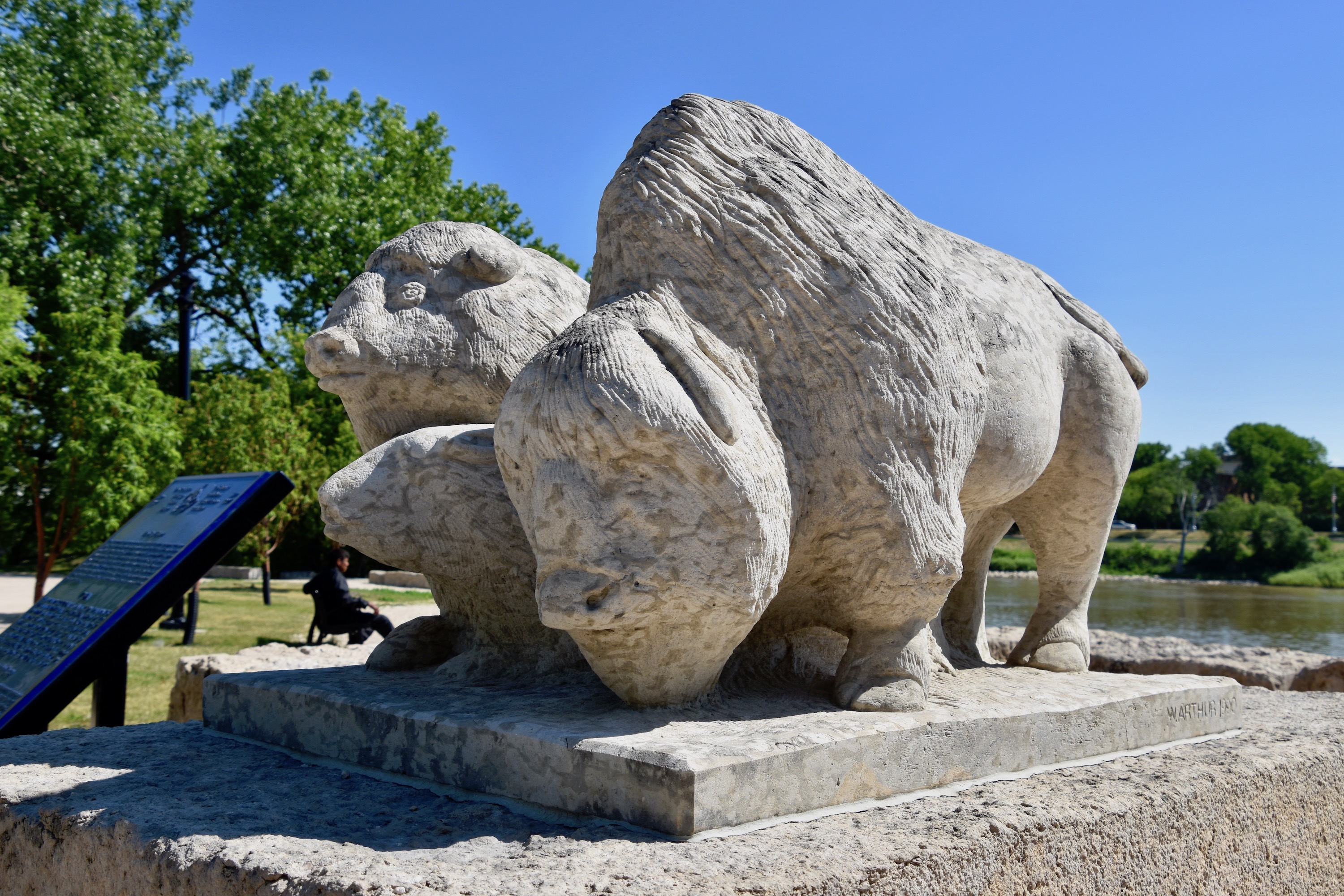
The Forks is actually where the Red River, flowing north from the United States and in places only miles away from the headwaters of the Mississippi River in Minnesota and the Assiniboine coming in from the west, meet. For thousands of years these rivers have provided the transportation routes for people and trade goods from as far away as the Gulf of Mexico and the Arctic Ocean, as documented by archaeological finds in the area. It’s been a natural meeting place for 6,000 years. The importance of this fact, as well as the more recent events that have taken place here, are why it is one of Canada’s most important and well visited places. The Forks National Historic Site provides a one hour tour of The Forks N.H.S. and explains why the ground you are standing upon is sacred to many Indigenous peoples and the Métis and has also hosted a series of forts and finally is a crucial piece of the history of the railway in Canada.
Alison and I were fortunate enough to have our own guide, Larissa Peck, who is the marketing co-ordinator for The Forks North Portage Partnership. We spent a considerable part of a beautiful Saturday morning touring The Forks in her company starting with this Parks Canada Indigenous monument.
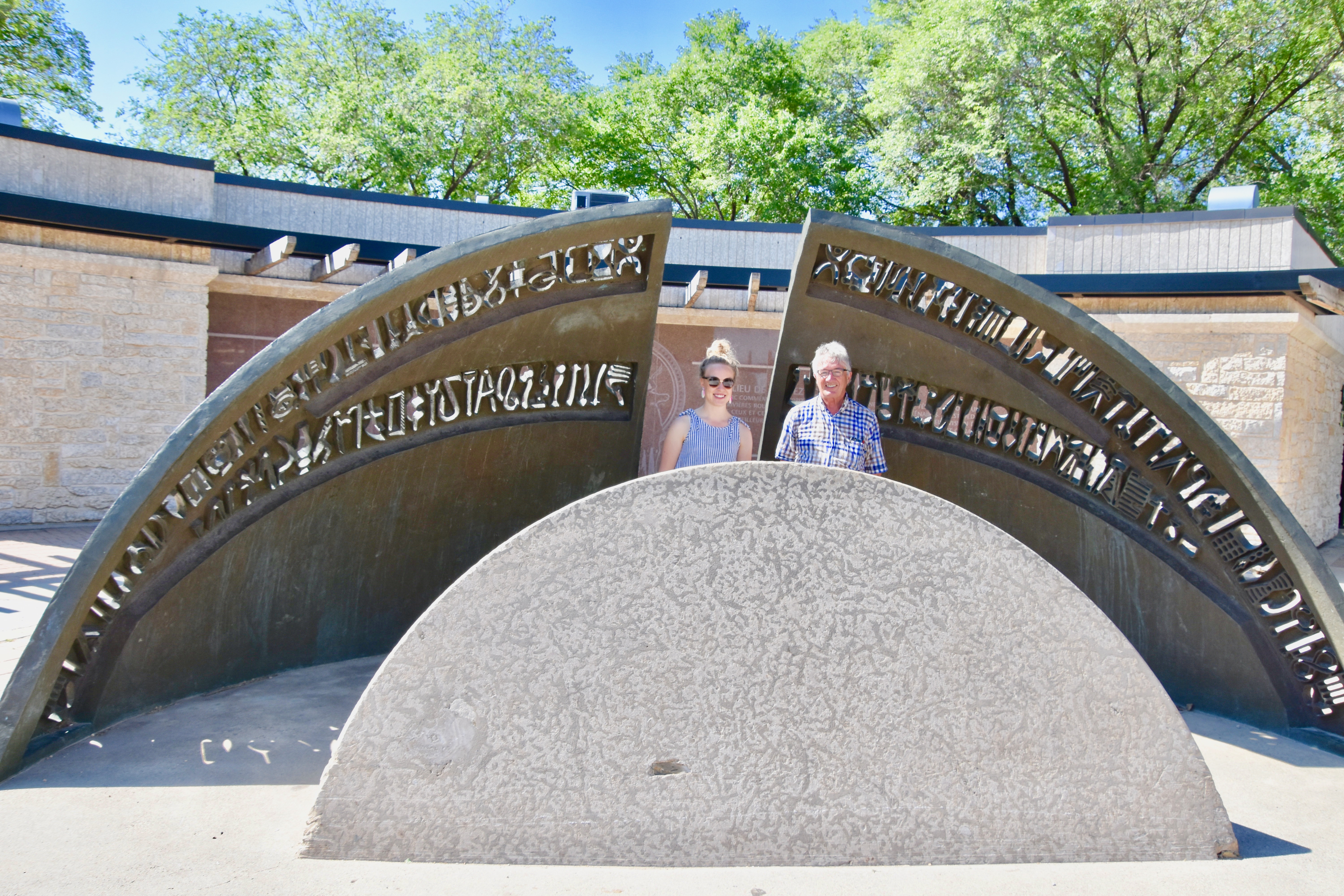
This is the place where, according to Indigenous oral history and supported to some degree by archaeological evidence, over 500 years ago a significant treaty was made between a large number of tribes, ensuring that The Forks would be a place of peaceful co-existence and trade. Today it’s a very nice shady spot just beyond the entrance to the Canadian Museum for Human Rights.
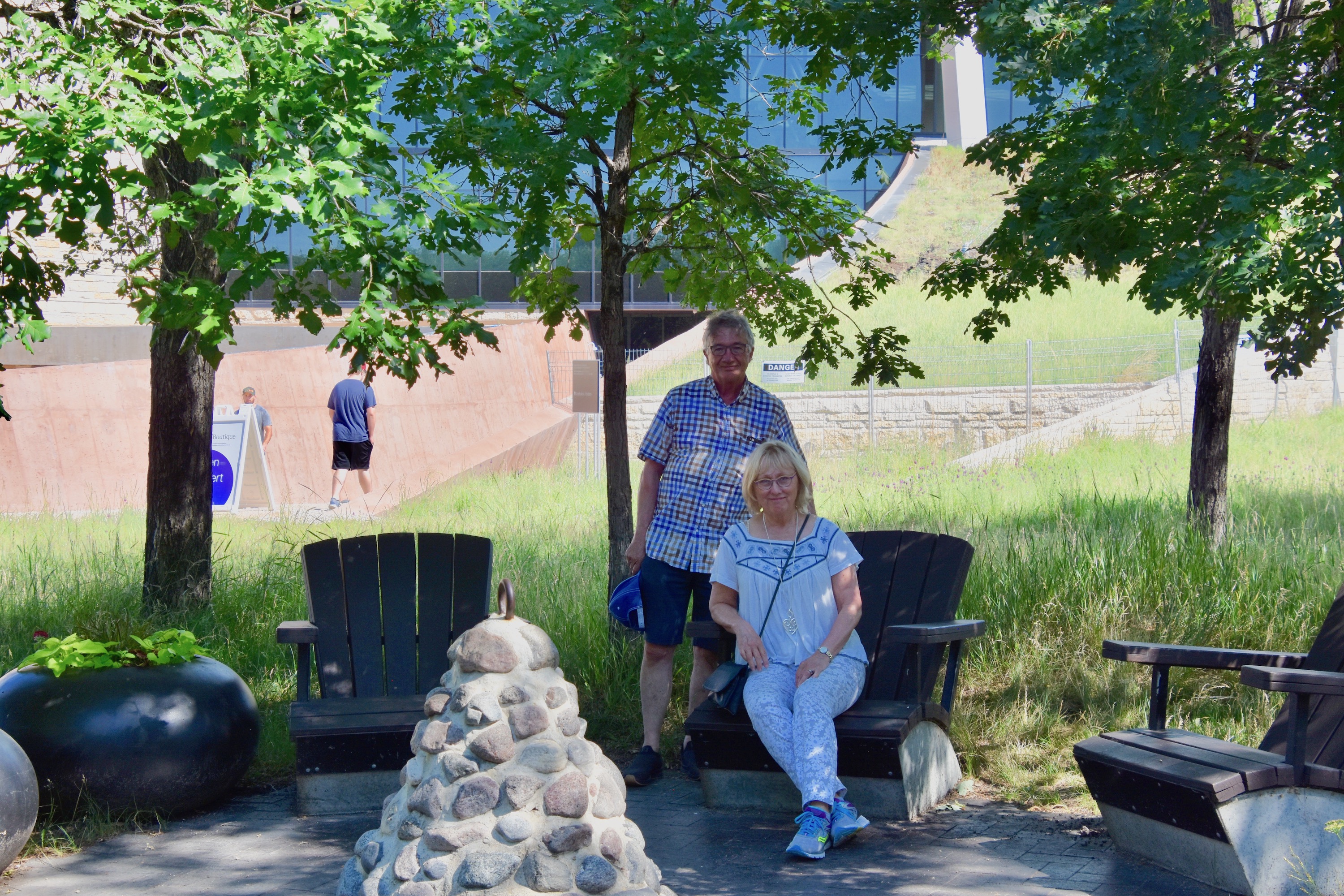
This is a photo looking across the Red River to the old St. Boniface Cathedral which was destroyed by a spectacular fire in 1968 and is now perhaps Canada’s most famous and photographic ecclesiastic ruin – our version of Tintern Abbey as it were.
I highly recommend taking a walk across the amazing Louis Riel pedestrian bridge and completing a 2.5 km. (1.55 miles) loop that will provide great views back of The Forks, the Riel Bridge and the Canadian Museum for Human Rights. This will also give you a chance to visit the grave of Louis Riel and numerous other important figures in the early history of Métis settlement in the area who are buried in front of the cathedral.
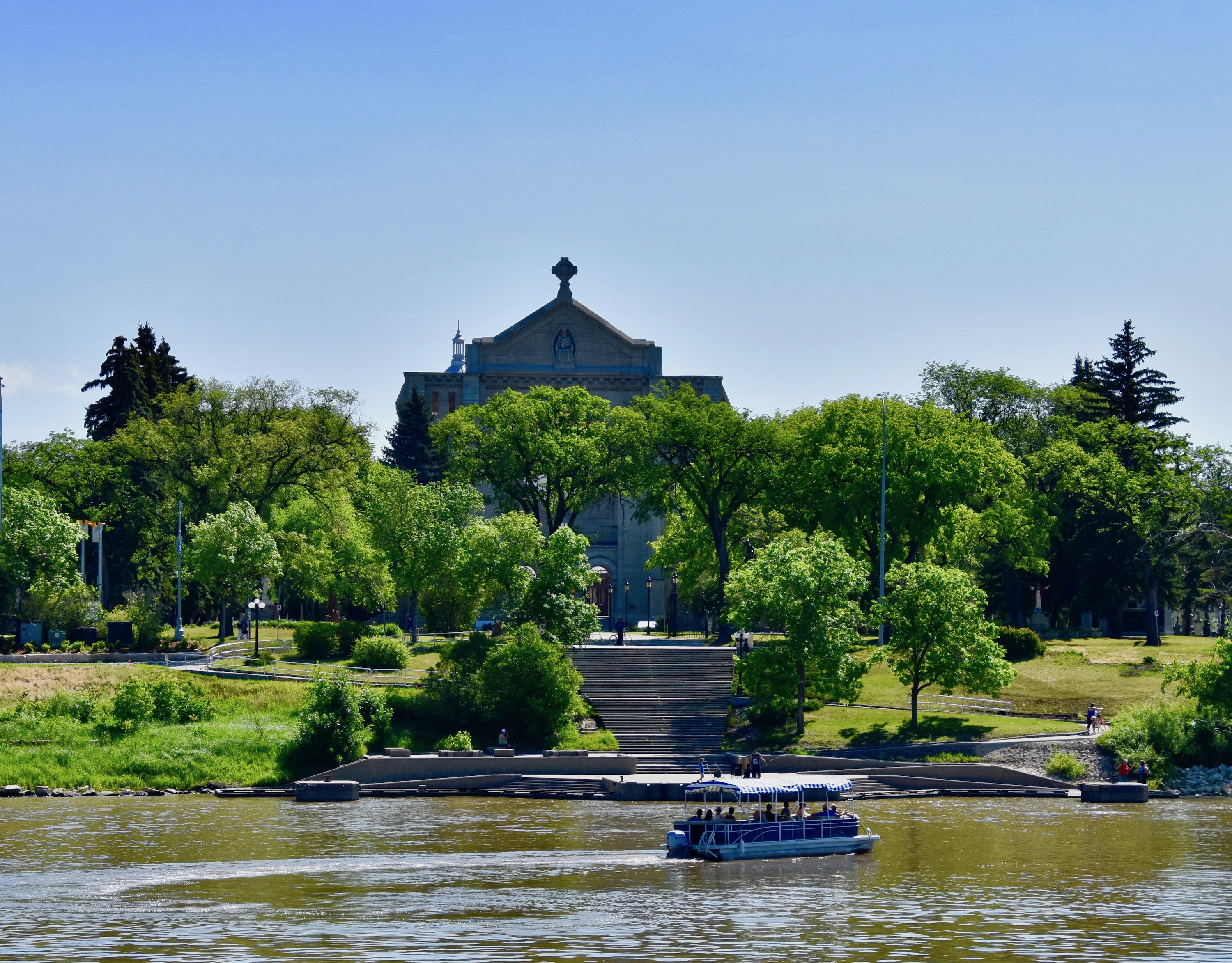
You will return to The Forks via an old railway bridge where you will find a mural by Mike Valcourt on the bridge’s counterweight which is a homage to Aboriginal Group of Seven artist Jackson Beardy.
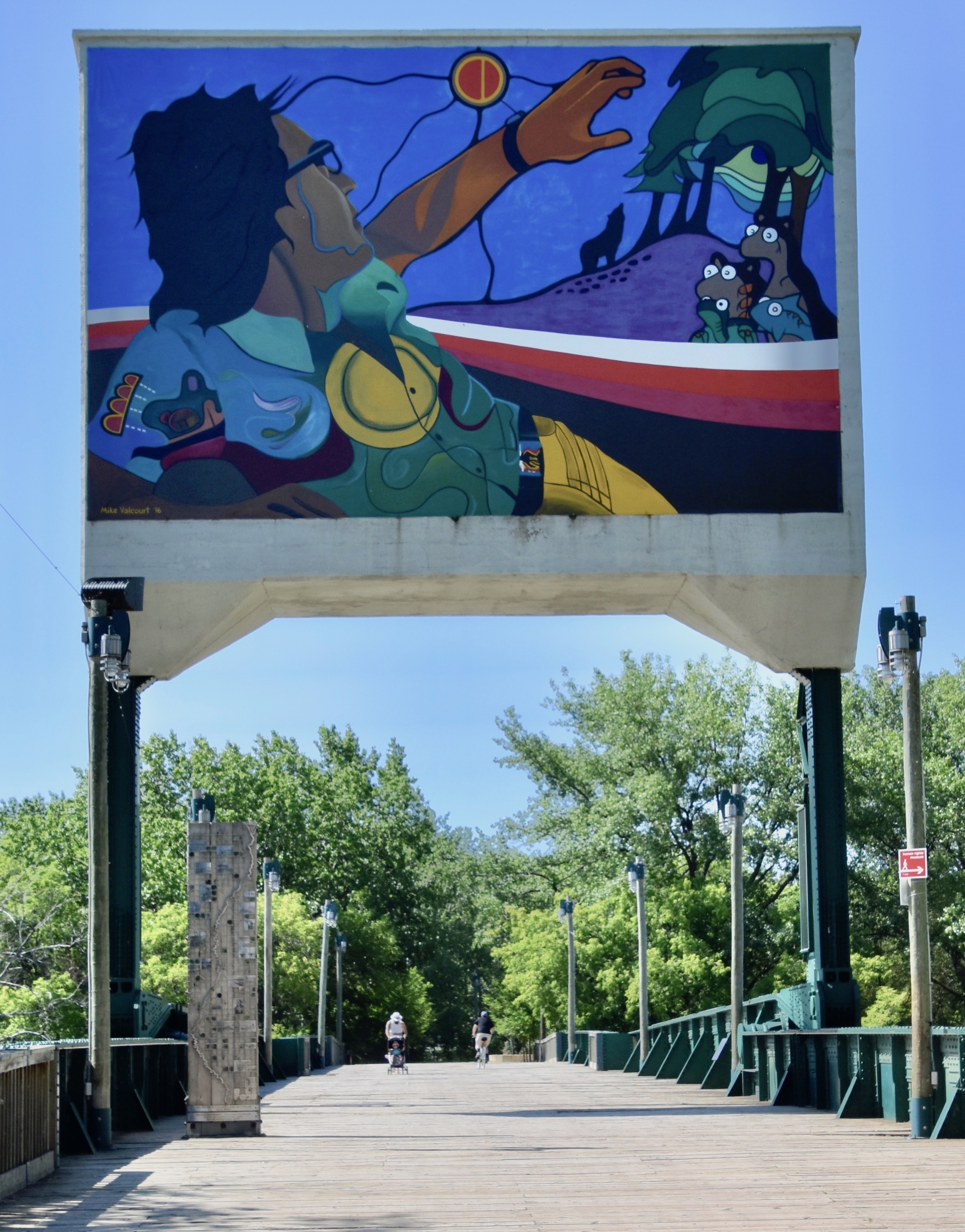
The railway bridge is also the best place to actually see The Forks. The bridge crosses the Assiniboine at the very spot that it enters the Red.
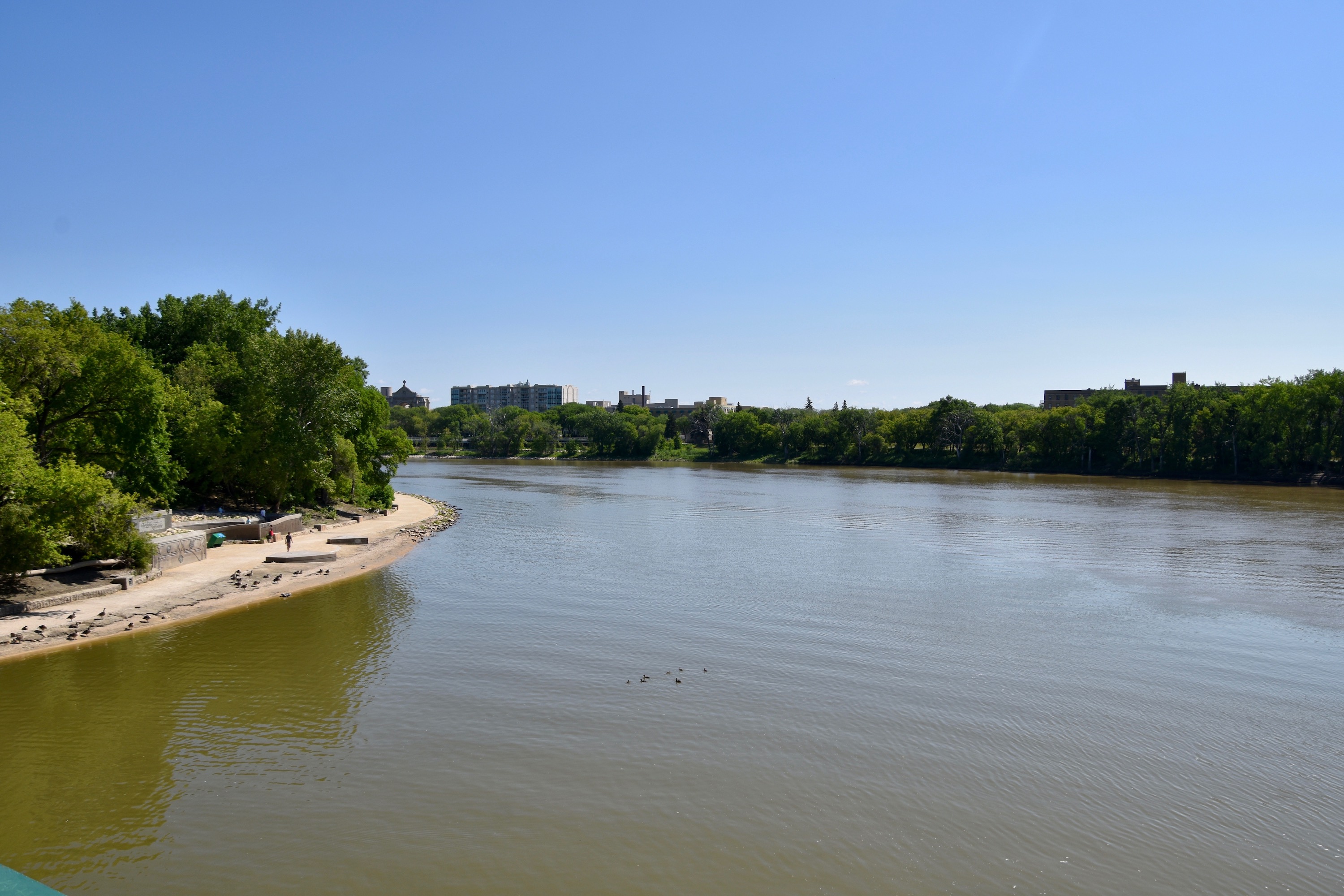
Alternatively, if you are not up for this short walk, you can plunk yourself down in one of those famous Parks Canada chairs and just watch the river go by.
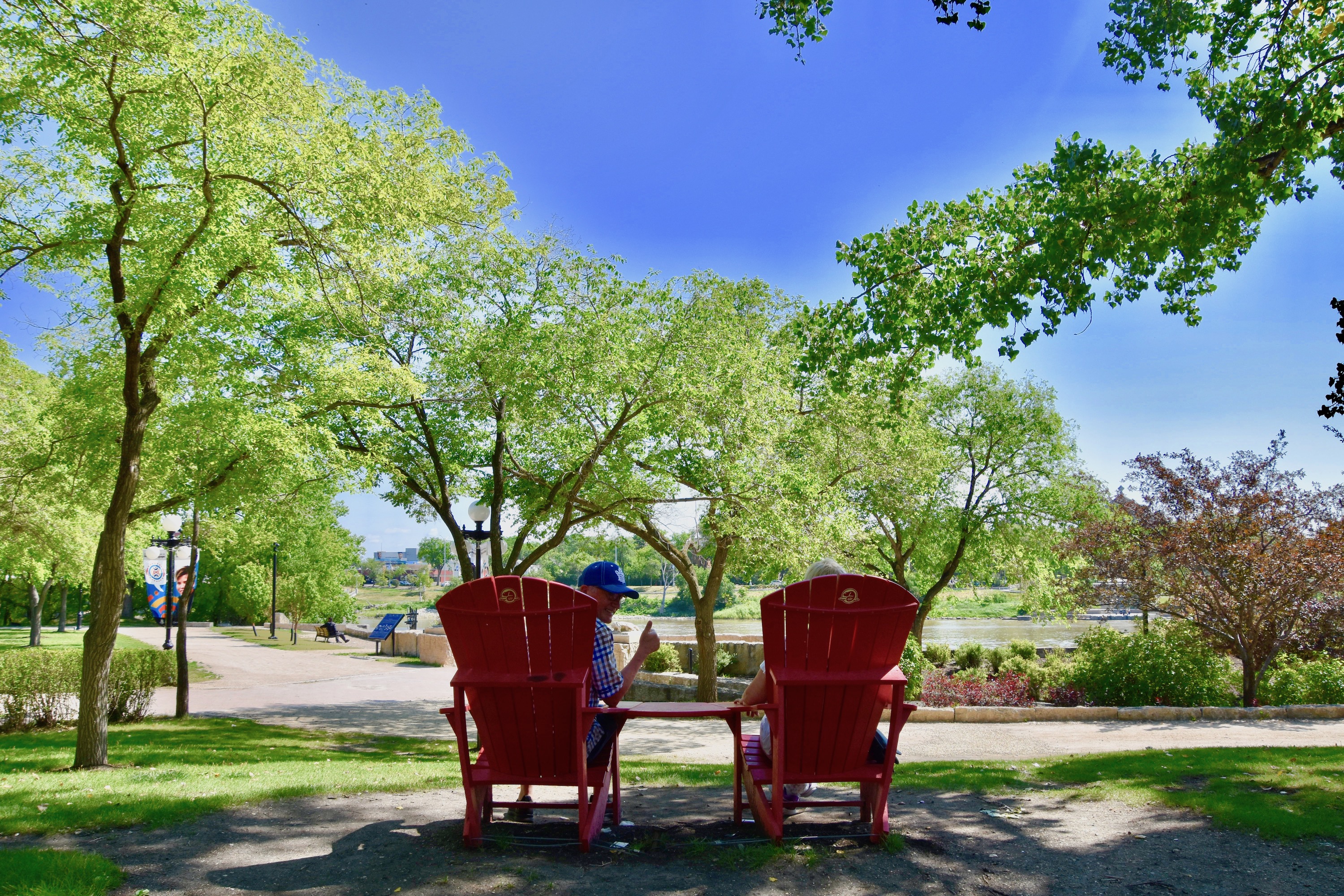
I mentioned stargazing as a possible activity at The Forks and at first blush that might seem a bit incongruous considering how much light pollution a city emits. This is the Oodena Celebration Circle one of the first of the Aboriginal inspired and directed attractions at The Forks. Oodena means ‘Heart of the Community’ in Ojibwe and is yet another reminder of just how important this location at The Forks was to the Aboriginal community. It is situate such that equinoxes and solstices are aligned at sunrise and sunset on those days exactly between the structures that look like alphorns, but are technically called monoliths.
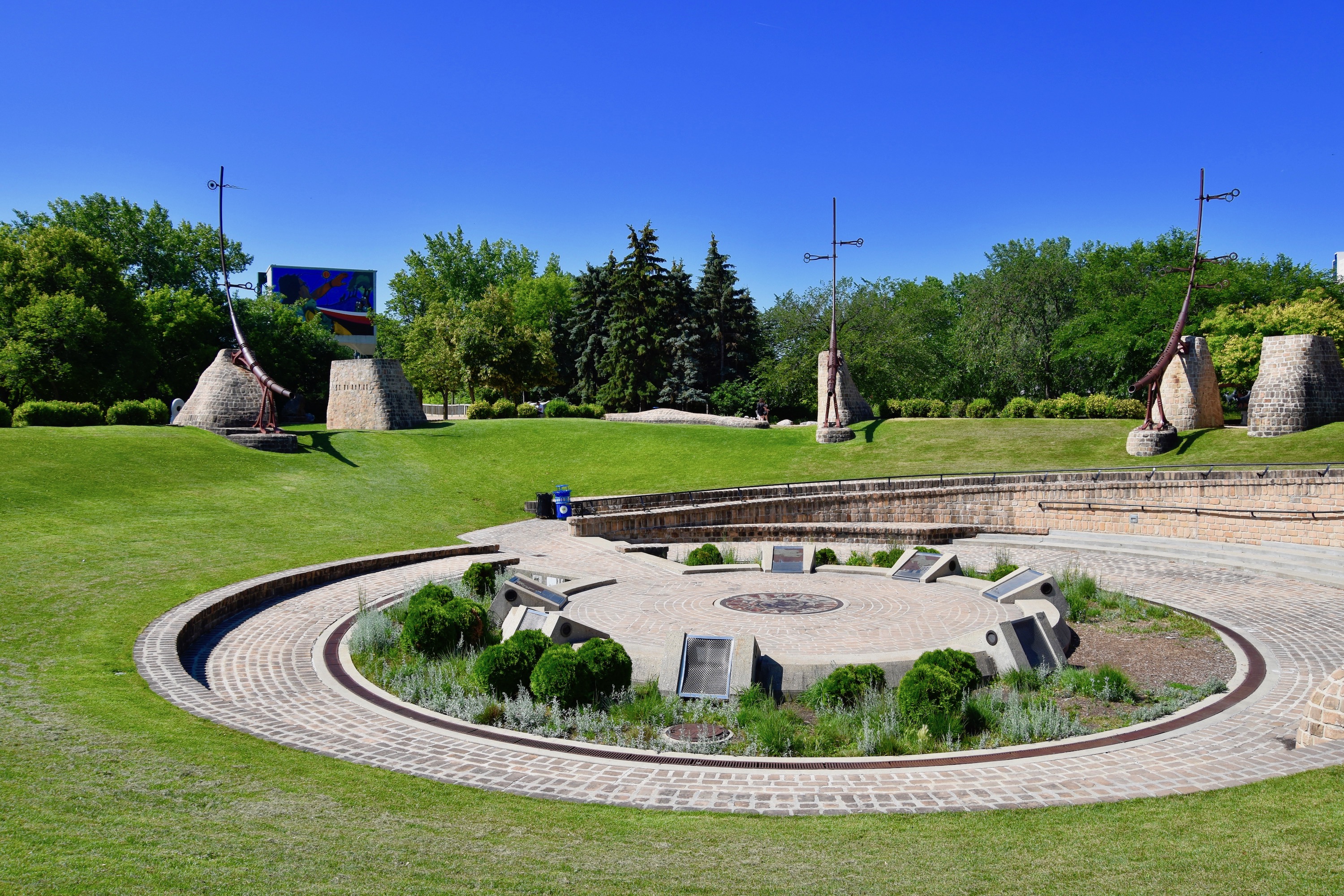
Each monolith has an armature attached that when viewed from the proper angle at night will outline a specific star or constellation. At the inside of the stonework at the base of each monolith there is a guide to what you can see and the importance or meaning of that star or constellation to various people’s around the world including the Chinese, the Hindu religion, Greek mythology, Aztec astronomy, ancient Egyptian and Mesopotamian myths and West African tribal beliefs. Growing up in a Western European based culture I always associate the constellations with the Zodiac and Greek based legends. At the Oodena I realized, almost like a light coming on, that every civilization that looked up into the sky, while seeing relatively the same objective star portrait, would almost by necessity come to different conclusions about their meaning and significance to that particular viewer. The Ooodena is a great metaphor for human diversity and thought – we are all seeing the same thing, but through different lenses and no single lens is more correct or important than any other. I can’t recall seeing anything similar in any of my travels.
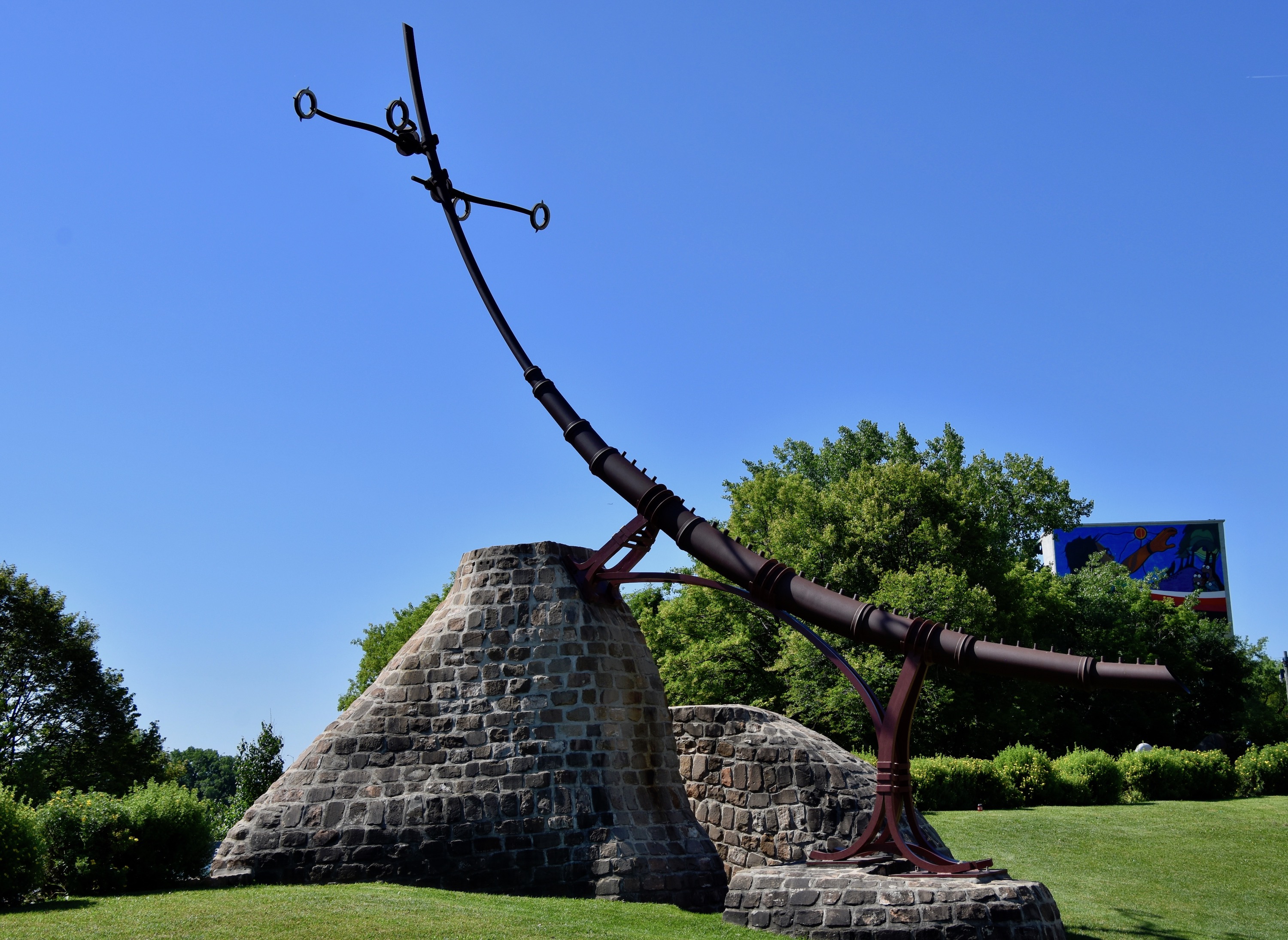
Throughout The Forks you will come to many areas where the original tall grass prairie with its profusion of wild flowers is being restored, one patch at a time.
You will also see great numbers of Richardson’s ground squirrels (aka gophers). They are always amusing to watch, but do create holes that are easy to trip over if you are not paying attention. Over the years the city has waged an on and offer battle with these cute critters with about as much success as Bill Murray had in Caddyshack. At The Forks natural predators like foxes are hawks are more likely to keep them in check than poisons or poison gas producing firecrackers (I kid you not).
The Market & Shopping
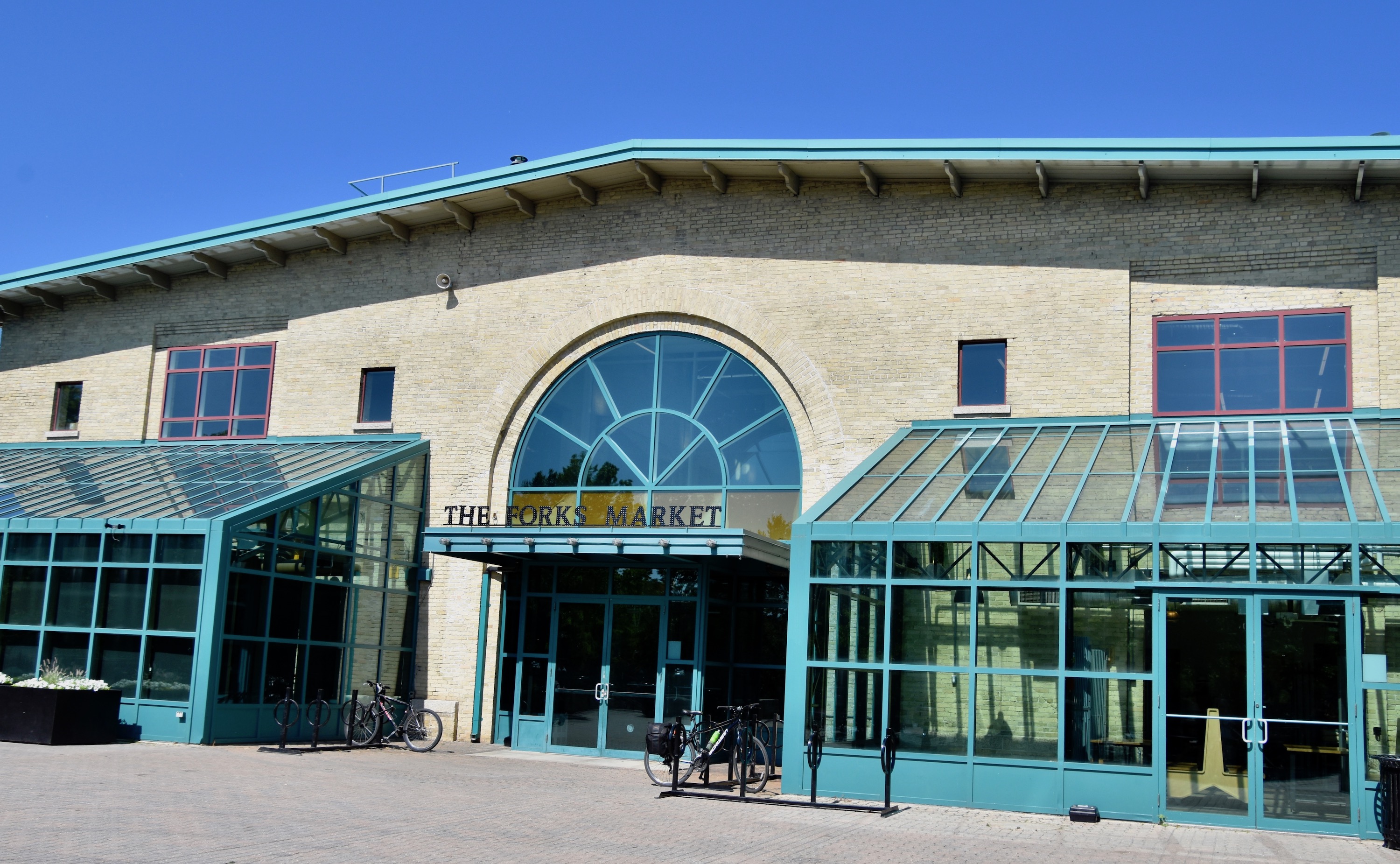
Once you’ve had your fill of history, culture and wandering you will undoubtedly head for The Forks Market where there are a tremendous variety of Winnipeg based businesses serving up at least fifteen different types of cuisine. As I mentioned at the outset of this post you will not find any chain restaurants here – just locally owned and operated companies serving great local food. The one exception, and it’s not in The Forks Market, but the adjacent Johnson Terminal building, is The Old Spaghetti Factory and I’m not going to complain about it.
Aside from the food, The Forks Market’s biggest draw is the building itself. It is a combination of two old stable buildings used by the Grand Trunk Pacific and the Great Northern railways to distribute goods throughout the city and surrounding area once they were delivered to Winnipeg by train. Long before semi-trailers loaded containers from ships and trains to head for distribution centres, horses were doing the same thing, carting goods to general stores and other businesses from the later 1880’s to the 1920’s when they were finally displaced by automotive power. It’s a reminder of a brief period in our history that most people do not even know ever existed.
When I lived in Winnipeg the entire Forks area was completed cut off by the rail yards and inaccessible to the general public. The only thing anyone knew was that there was supposed to be a lot of old abandoned buildings between the railway and the river. All I can say is thank goodness they were so isolated and forgotten about or they would undoubtedly not have survived. Today, it’s a beautiful stone and steel palace in which to grab a bite or have a serious meal, like for example a 20 oz. ribeye from Smith’s Steaks.
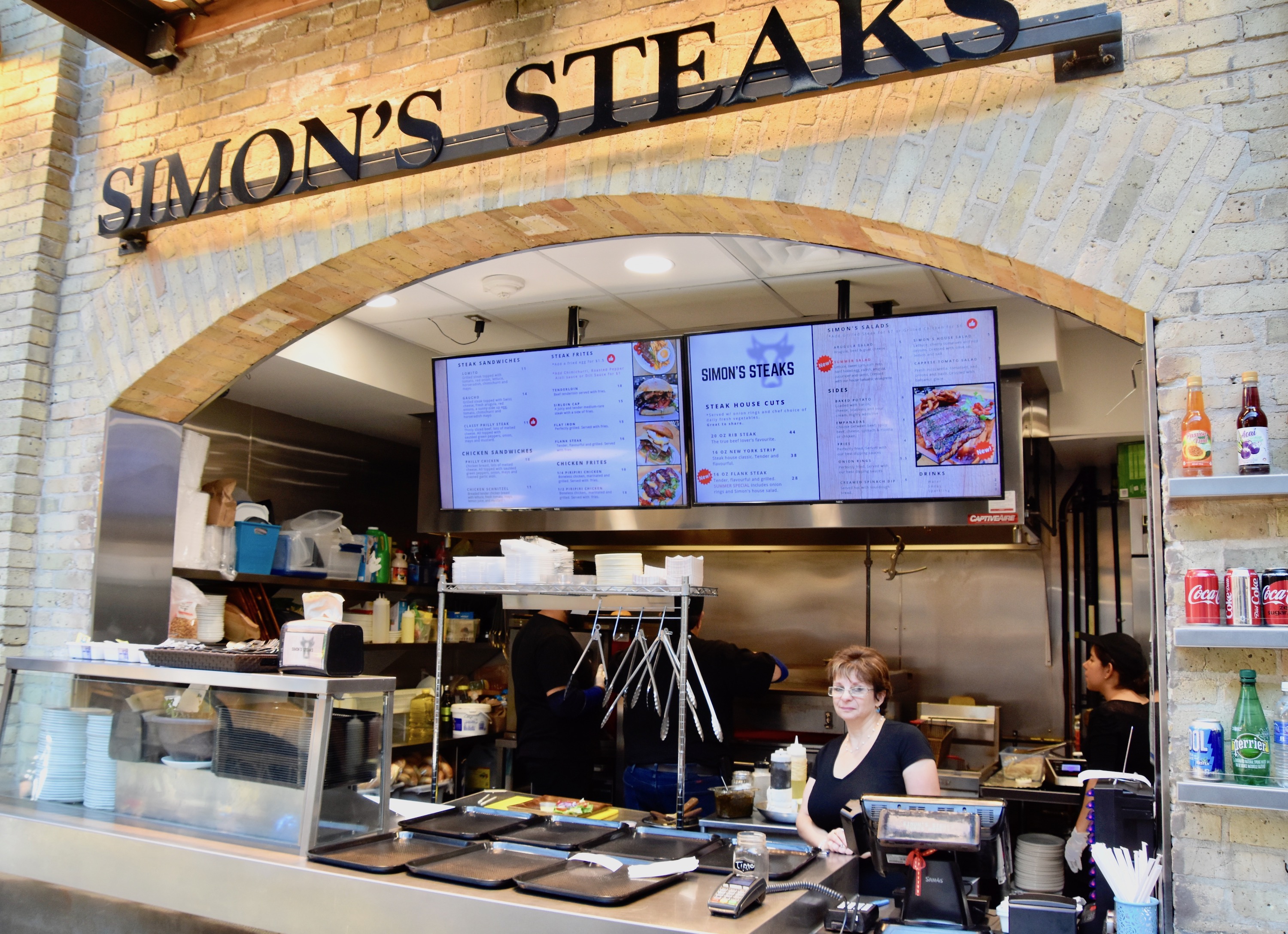
Each morning we visited The Forks Market we could not resist the offerings from Tall Grass Bakery which is totally organic and justly famous for its sticky buns, but I’ll put its croissants up against any made in this country, including Quebec. The cheese and almond varieties immediate became Alison and my favourites respectively. This is a must visit place in the market.
We can also vouch for Red Ember Common which serves great thin crust pizza prepared in an oven not ten feet from the counter where you eat it. Or better yet, take your pizza outside and find a table in the large common area. Then choose from one of the 20 beers or 20 wines at The Common to go with it and enjoy an al fresco meal.
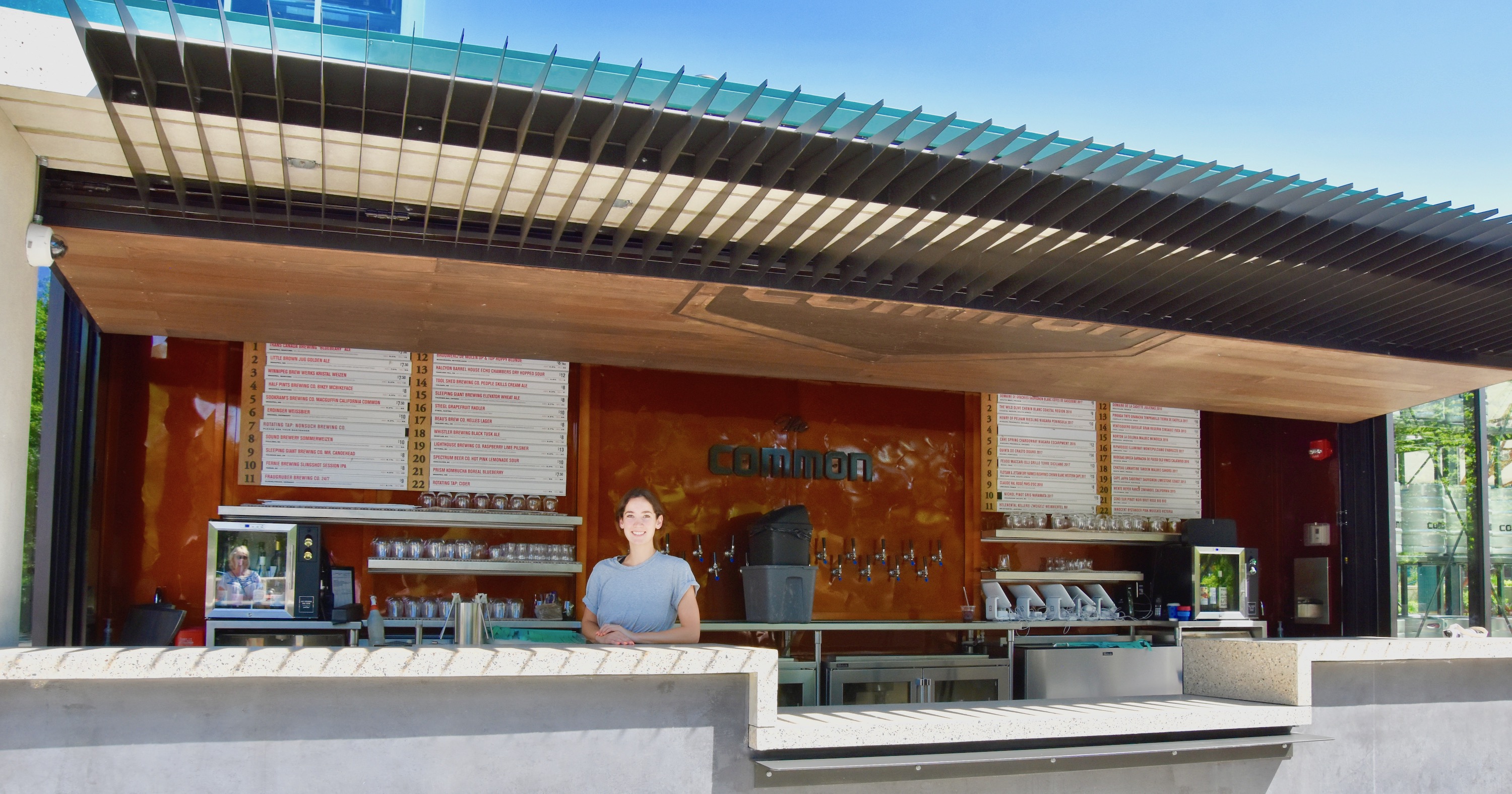
One of the reasons to keep returning to The Forks is just to sample the food from every one of the vendors – there wasn’t one we didn’t want to try. One of the top on my list would be Taste of Sri Lanka a cuisine that is on my bucket list as I understand their curries are particularly spicy and pungent. If I you can’t get to Sri Lanka this might be your second best choice.
I am most definitely not a shopper. You cannot pay me enough to go into a Walmart or Costco, but I actually enjoy poking around the shops at The Forks because the stores are not chains and the merchandise for sale is not something you are going to find in most shopping malls. Also, the Johnson Terminal and The Forks Market buildings are unique places to shop. If you are looking for genuine items of Canadian made Indigenous clothing there are several shops that will oblige. For the past ten years or so I have been buying moccasins here which are my slippers of choice at home and on the road.
My favourite store at The Forks is Kit and Kaboodle which is a huge toy store with the largest selection of jigsaw puzzles I’ve ever seen. As a jigsaw puzzle aficionado it’s really hard to decide on buying just one. It’s also a great place to look for gifts for children and in my case, grandchildren. Another great place to browse is Johnston Terminal Antique Mall which occupies the entire basement of the building and has over 7,000 square feet of everything you can possibly imagine they call antiques these days. Lot’s of crap, but the occasional treasure as well; you just have to find it and that’s the fun part.
The Inn at The Forks
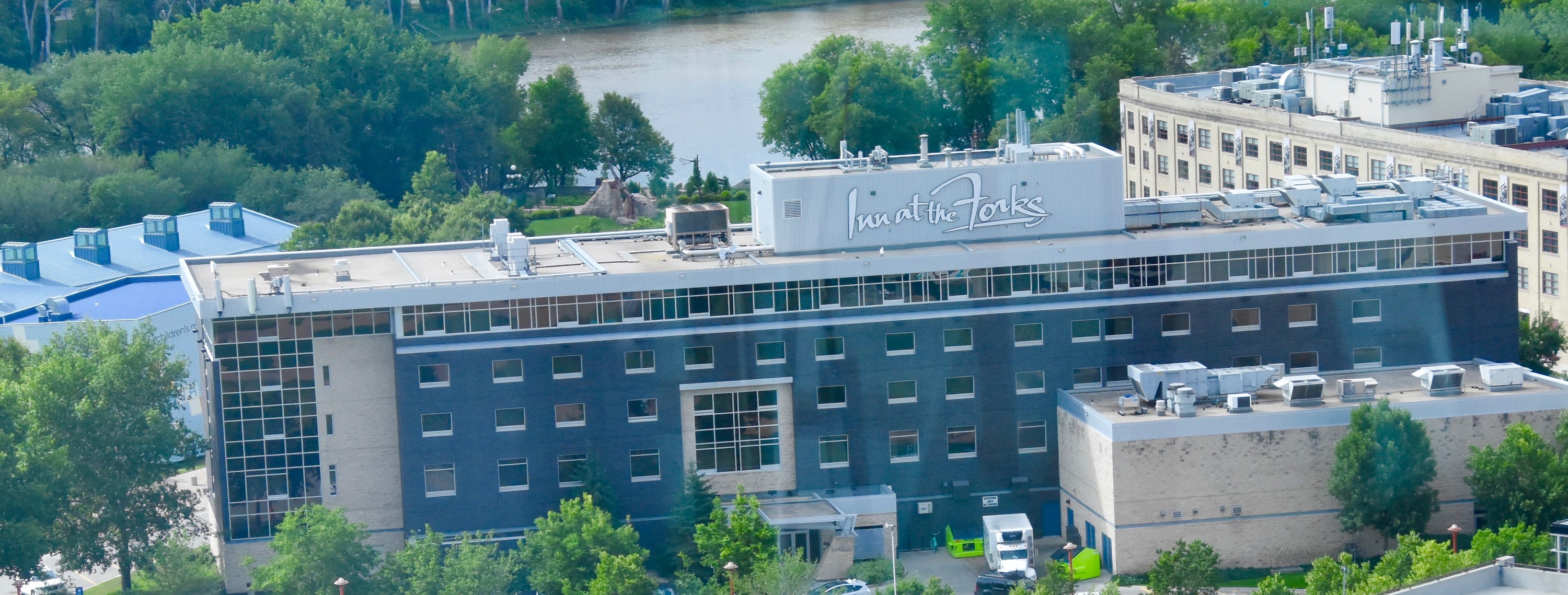
Winnipeg is not an expensive city to stay in relative to Vancouver, Toronto or even Halifax, but it’s got very little in the way of what I would call memorable places to stay. For sure there is the iconic Fort Garry Hotel which dates from the grand railway era and is not far from The Forks. But aside from that, for me the only other choice is the Inn at The Forks which as you can see from this photo I took from the top of the Canadian Museum for Human Rights, is right in the middle of The Forks.
The rooms either face out on The Forks or on the other side, provide great views of the museum and the Winnipeg skyline. I’ve stayed there a number of times and enjoy the spacious and airy rooms with plenty of working space.
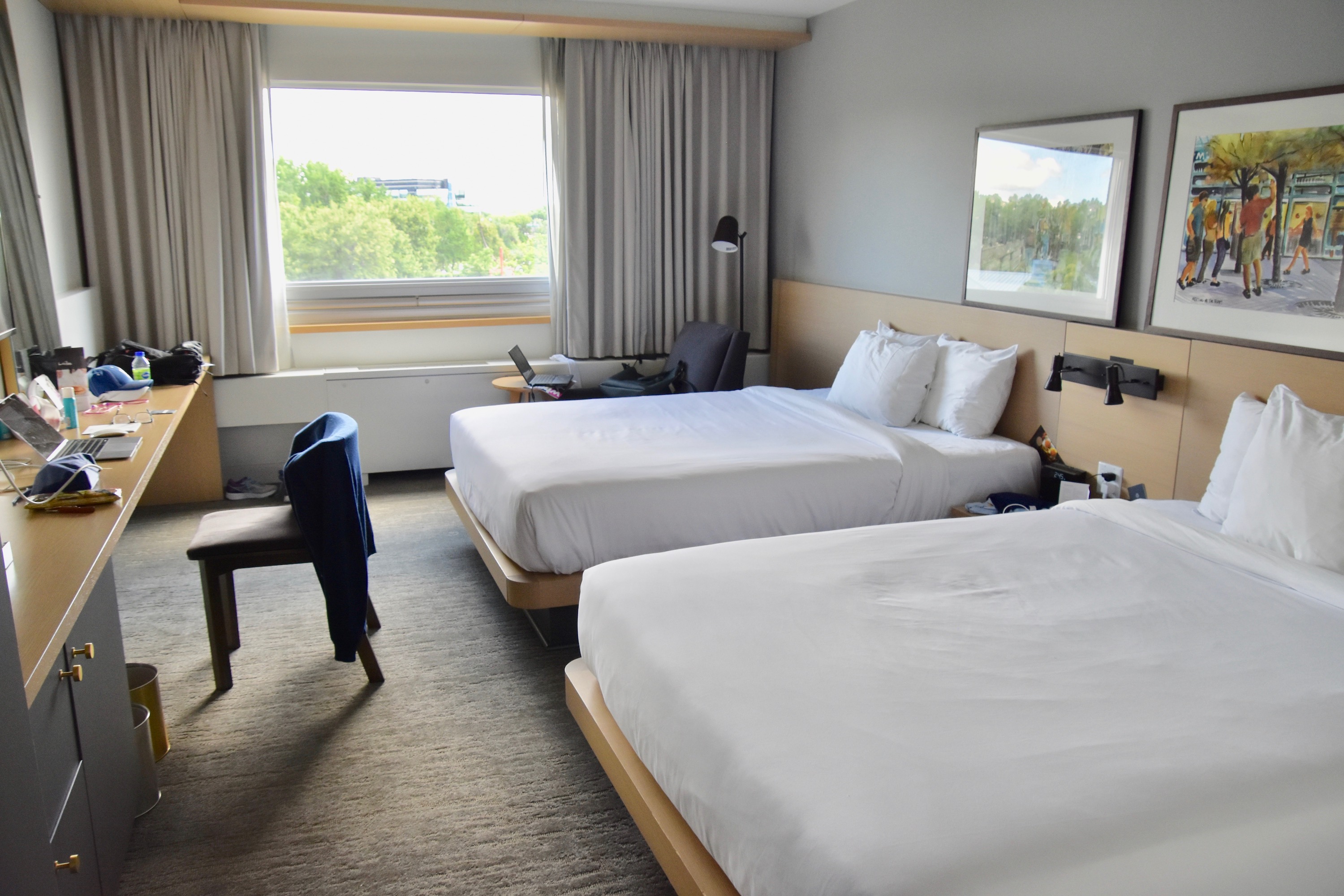
I also really like Smith, the bar and restaurant at the hotel which serves great martinis, charcuterie, small plates and the dish that has made the place famous – buttermilk fried chicken. If you can tear yourself away from the places at The Forks Market make sure it is to try this amazing recipe at Smith.
Yes, staying at The Inn at The Forks is more expensive that most other places in Winnipeg, but compared to the top hotels in most Canadian cities, it’s a bargain. There is no substitute for being in the centre of the action and this is it.
This post is already long enough and I haven’t even mentioned many of the other attractions at The Forks like the terrific Travel Manitoba Visitor Centre where you can plan your itinerary to visit this most underrated of Canadian provinces. Or The Children’s Museum, or the Broadway Promenade where you can get your picture taken with Mahatma Gandhi.
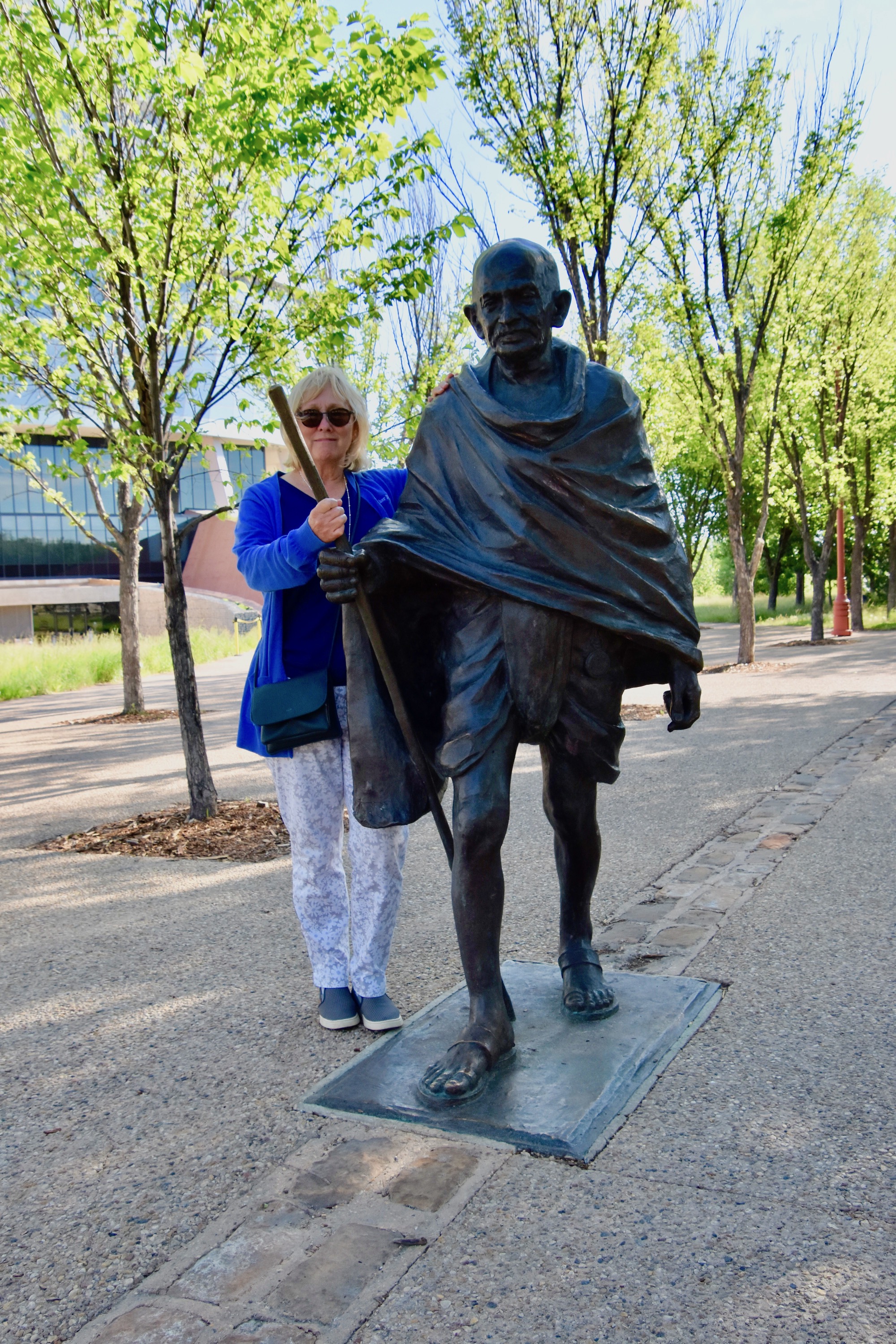
The Canadian Museum for Human Rights
However, if there is one other place you must visit while at The Forks it is the Canadian Museum for Human Rights
A few months before it opened in August, 2014 Alison and I were privileged to have a tour of what was then a completed building without exhibits. At the time I wrote this post about it and predicted that it would quickly become an iconic building that would transform Winnipeg as a tourist destination. I wasn’t the only one who expressed those thoughts, but many others scoffed at the idea that this building could compete with the Sydney Opera House or Frank Gehry’s Guggenheim Museum in Bilbao, Spain. Well, take a look at a newly minted Canadian $10 bill and see what’s on it. In less than a decade this building has become a powerful symbol for human rights around the world.
Simply put, it’s a beautiful piece of complex architecture. You’ll definitely want to get your picture taken sitting in the Winnipeg sign with the museum in the background.
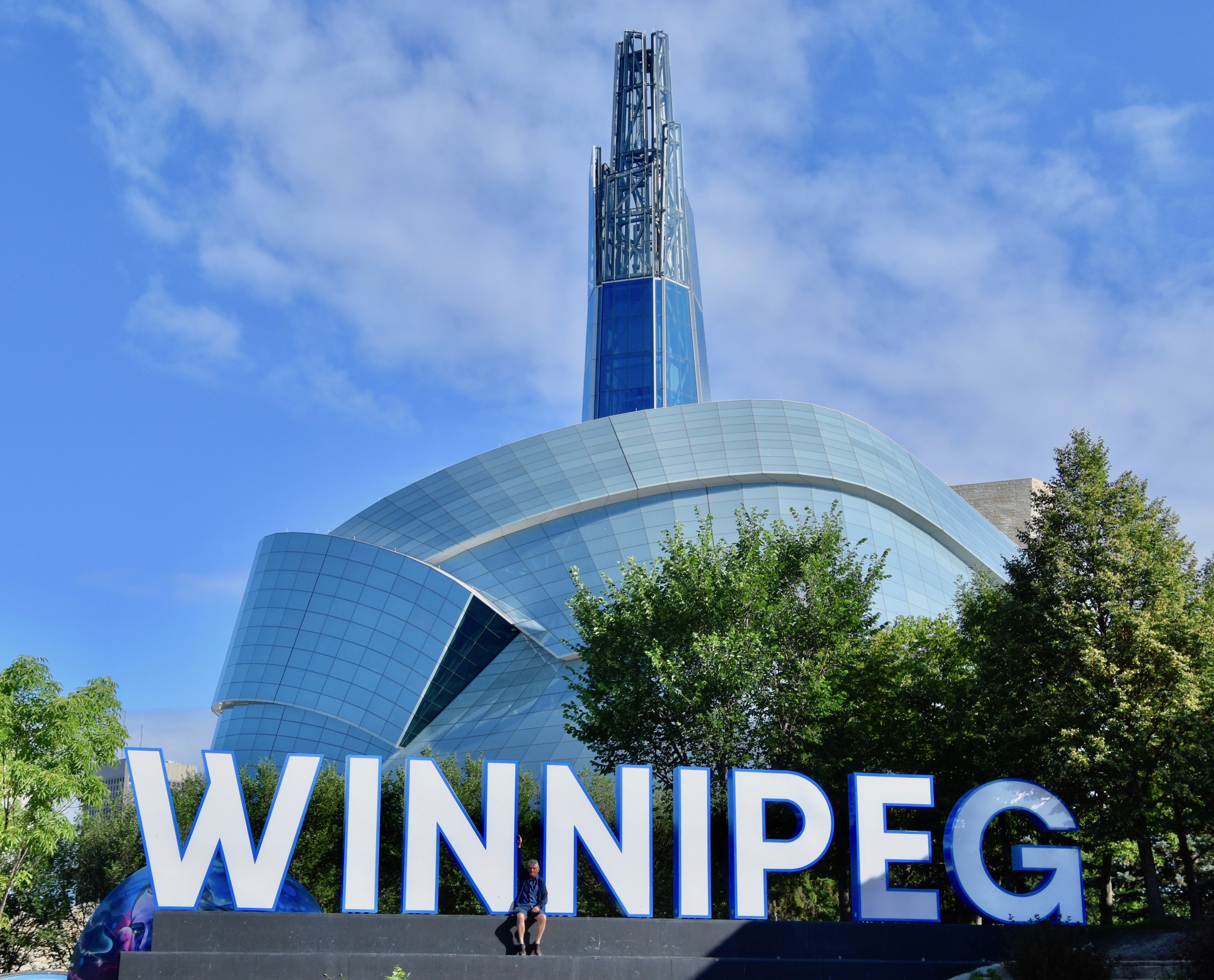
Alison and I were given a guided tour of the museum on our recent visit by fellow TMAC member Maureen Fitzhenry and I cannot stress enough that taking one of the guided tours offered by the museum will make take your experience to another level of appreciation. However, almost as good an alternative is to download the museum’s free app to your smart phone and use it to guide you. Also, pick up the paper visitor guide which is a great souvenir and reminder of what you have seen.
The museum uses the most modern technology I’ve seen in any public institution to provide an in depth multi-media interactive experience that I really can’t describe in words. This is not a place you can take in during one visit. It is simply too large and has so many things to occupy your time and mind that trying to do it all at once would be simply exhausting. So I’m going to include photos I received from the museum to highlight just a few of the spaces you’ll see on your visit.
This is Buhler Hall where you are greeted by huge shadow figures that move through a sea of languages.
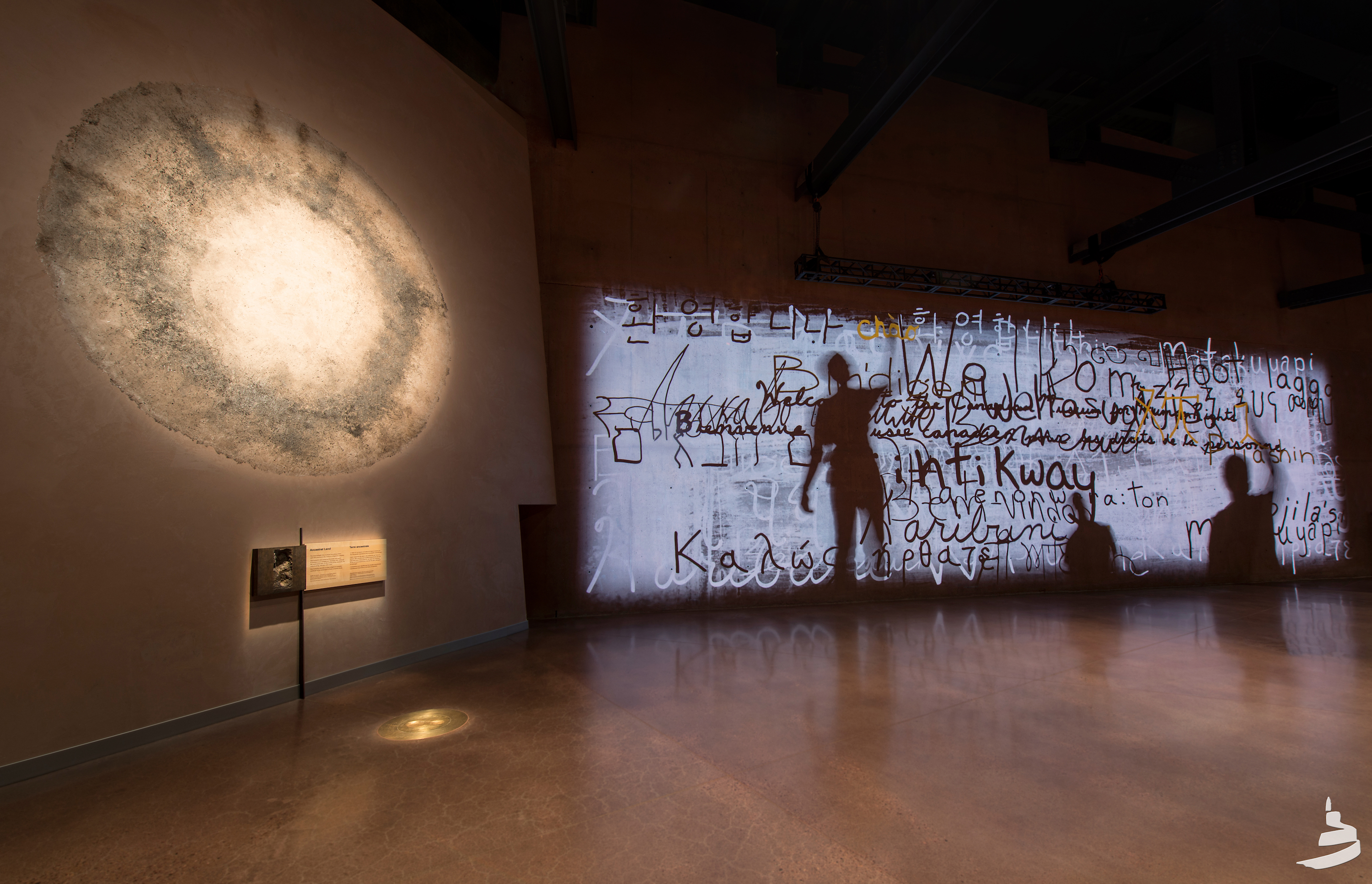
The second level contains a large gallery, Indigenous Perspectives where this 360° theatre shows a short film of how the world around us is perceived by Indigenous people and their rights and responsibilities in maintaining it.
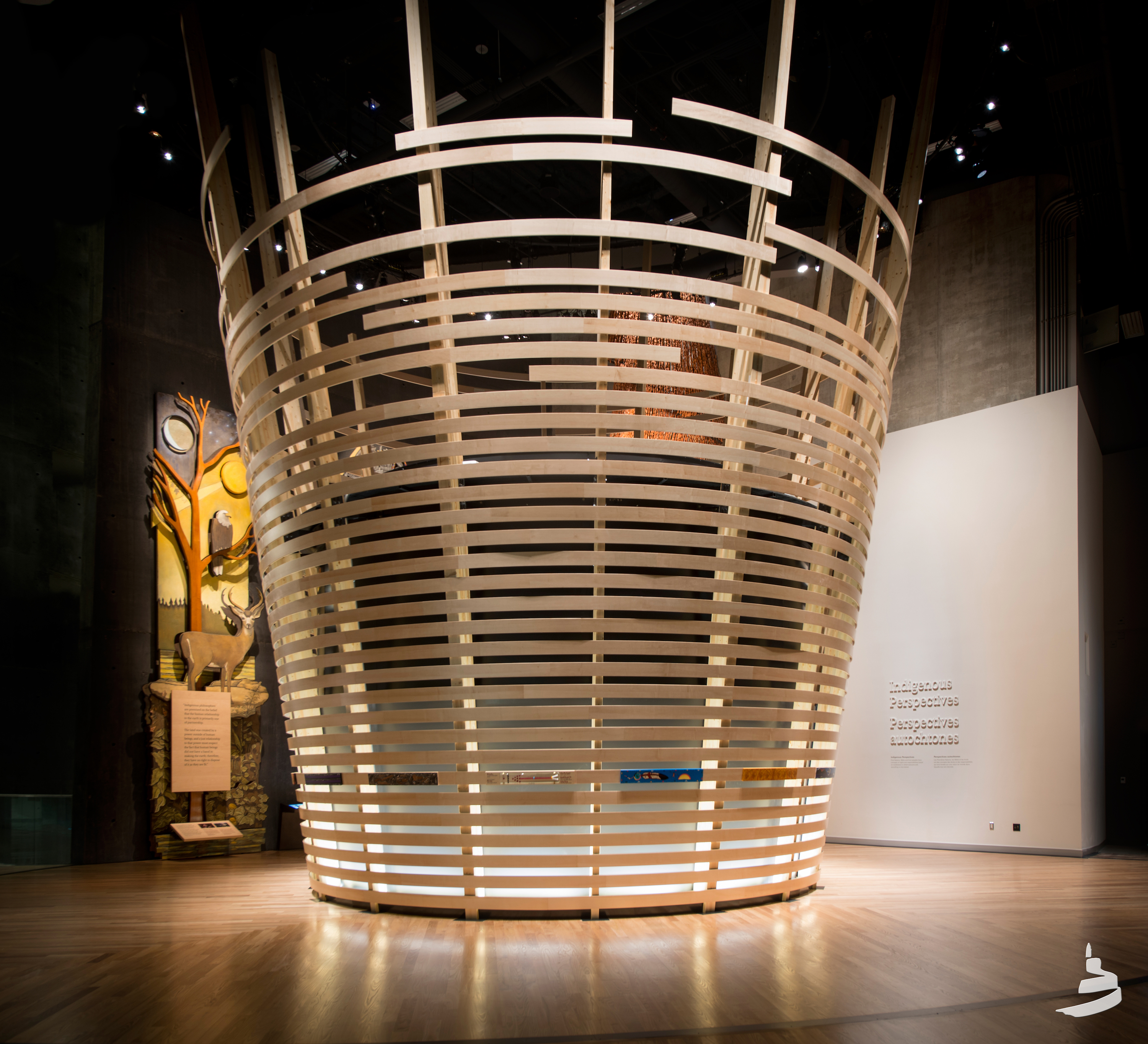
This is the Canadian Journeys gallery, the largest in the museum and it has kiosks that document the travails and triumphs of the dozens of different peoples that make up Canada today. That horseshoe shaped thing in the middle is an amazing feat of technology that allows groups of people to digitally connect with one another in a way you’ve never experienced before.
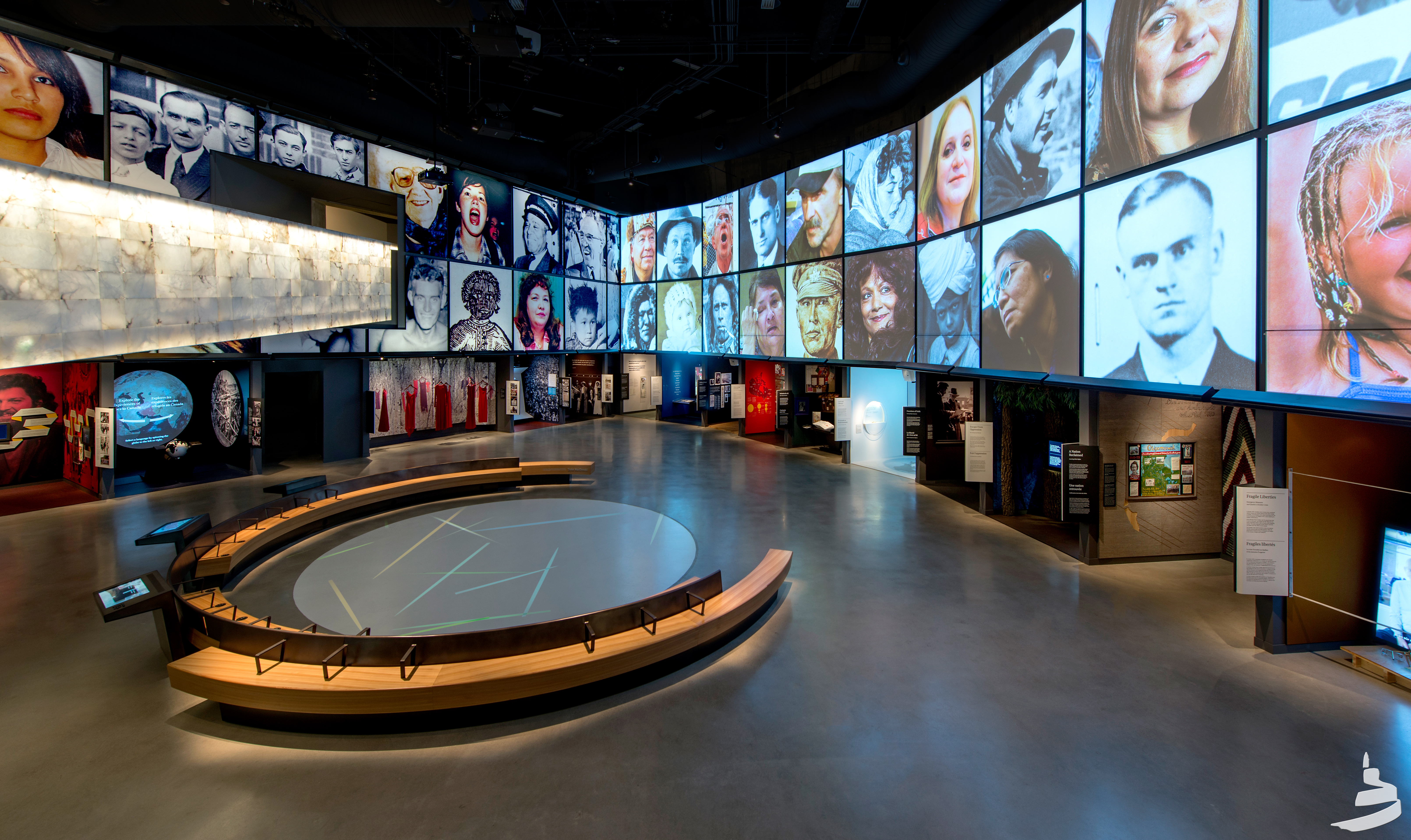
In the gallery Inspiring Change you can write your own note on how you would improve human rights and put it up with thousands of others from visitors from around the world. Or you can read what some of the most famous people to have visited the museum have written.
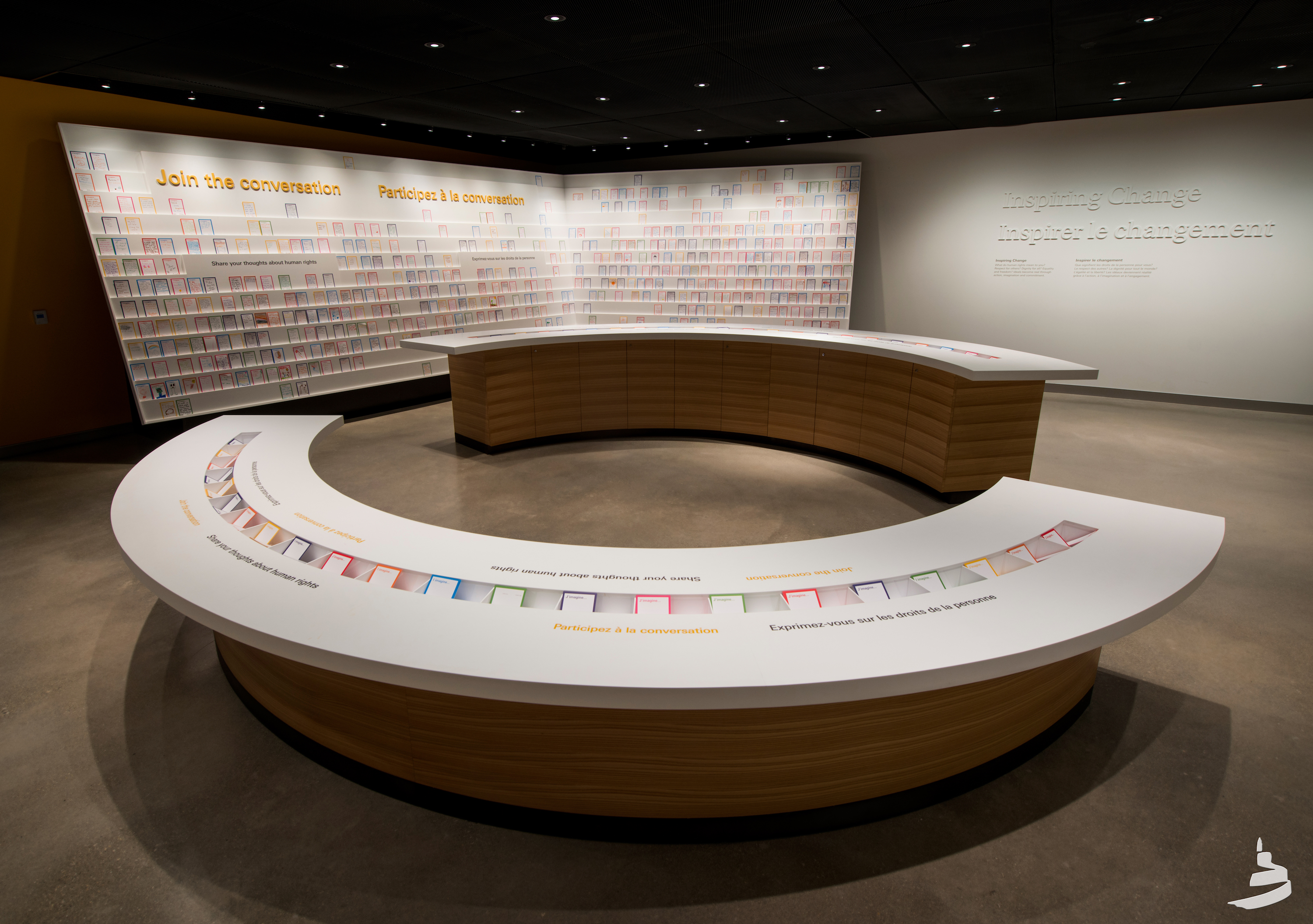
However, for me the most stunning part of the museum is the architecture, inside and out. You ascend higher and higher on ramps of translucent alabaster that fairly glow brighter the higher you go as more and more sunlight penetrates the interior.
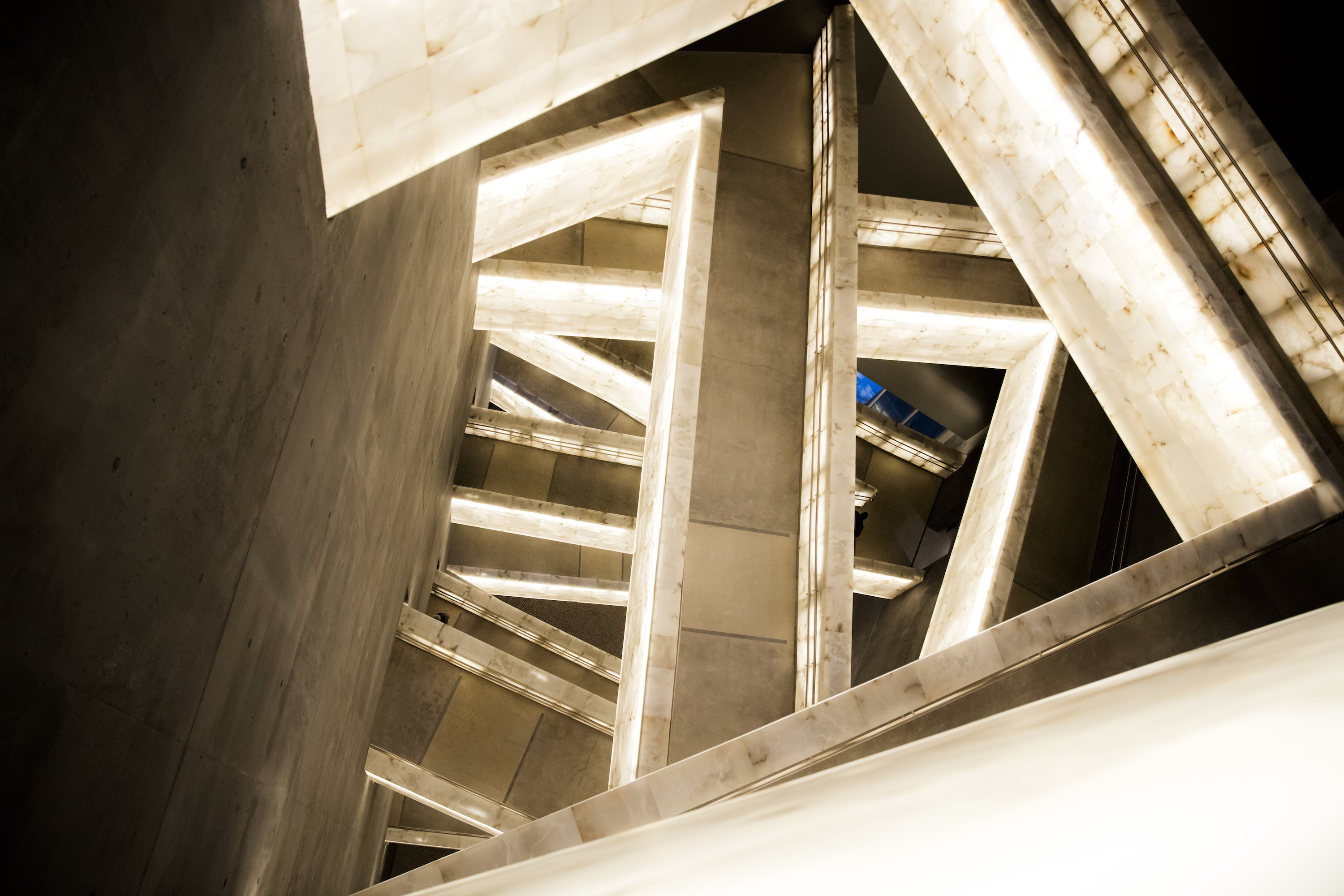
At the 7th level you can take an elevator or walk the stairs to the Israel Asper Tower of Hope for a phenomenal view of the city of Winnipeg and The Forks below.
To complete our visit we walked through a special exhibit on the life and times of Nelson Mandela which was more than worthwhile on its own accord. Lastly, after visiting the museum’s Boutique where I bought my mandatory fridge magnets, we had a great lunch at the ERA Bistro.
In my opinion the Canadian Museum for Human Rights has transformed Winnipeg and made The Forks an even more desirable destination for locals and tourists alike.
So that’s my take on The Forks and I hope I have convinced you that Winnipeg is no longer a place you just go through to get somewhere else. It’s now a world class destination that can hold it’s own with any Canadian city and this is coming from a guy who at one time couldn’t wait to leave.

